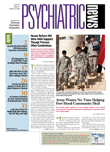Cognitive-behavioral therapy (CBT) appears to be the treatment of choice for pediatric obsessive-compulsive disorder patients, and clinicians from around the world are working on a variety of ways to deliver it effectively.
At the American Academy of Child and Adolescent Psychiatry's (AACAP) annual meeting in Honolulu in October, Tord Ivarsson, M.D., Ph.D., described a follow-up study using cognitive-behavioral therapy with pediatric patients with obsessive-compulsive disorder.
Ivarsson is an associate professor of child and adolescent psychiatry at Sweden's University of Gothenburg and the Centre for Child and Adolescent Mental Health of Eastern and Southern Norway. He based his work on 1997 guidelines published by John March, M.D., M.P.H., who chaired the program at the AACAP meeting. Of the 109 patients in his naturalistic study, 14 were classified as having mild OCD, 49 moderate, and 46 severe.
The key to the program was taking the exposure-based therapy to the patients in their homes. Not only did that obviate the potential barrier of their having to get to the clinic, it improved the focus of the therapy, said Ivarsson.
“Home delivery of treatment helped us evaluate the patient's setting and look at antecedents of rituals,” he said. “It is easier to make a good map of OCD when you are in the home.”
Treatment was rather more intense than might be done in the United States. Therapists worked with patients for six months, in up to 40 sessions. However, there was little additional benefit beyond 20 to 30 sessions, he said. About 60 percent of the patients also took the SSRI sertraline.
Patients were evaluated at six, 12, 24, and 36 months. By six months, half had symptoms classified as mild or below. Most of the severe and moderate cases “melted away,” in his words, by 24 or 36 months. There were 25 patients missing at the end of the study, but Ivarsson said they likely dropped out because they were doing well.
“Dropouts were doing better than optouts,” he said.
Patients with higher baseline symptom scores did proportionately better with treatment, while the 31 patients with Tourette's syndrome did less well than others as time went by.
“Gender, age, and comorbidities had little effect on treatment, except for those with Tourette's syndrome,” he said.
Nevertheless, available treatments were still not good enough, said Ivarsson. “Perhaps 15 percent still had moderate to severe OCD, and 30 percent still had OCD in the clinical range.”
A British researcher found that despite the good evidence for using CBT with OCD patients, many young patients were showing up in her clinic either with no prior treatment or on antidepressant medication only. Parents told her that there was no one available to help their children, said Isobel Heyman, M.B.B.S., Ph.D., of the Institute of Psychiatry at King's College London and the Maudsley Hospital.
So she developed a pilot study of old-technology telepsychiatry, using telephone interventions for OCD. Ten patients aged 12 to 17 were given 14 sessions within 17 weeks. Strategies included homework and relapse-prevention techniques. Parents were involved on a second phone line at the home, and both parents and children reported sustained improvement in quality of life at 12 months.
Being in the home during therapy is critical for patients, said Heyman.
“It has to take place in the setting where the fear you're trying to extinguish occurs,” she said. “You don't want them walking around town with their cell phone.”
Heyman is now recruiting adolescent patients for a larger trial comparing telephone with face-to-face CBT. She worked to overcome one glitch that hadn't appeared in the pilot trial. Parents in the telephone arm of the new trial have needed her reassurance that their children are receiving treatment using the same manual and procedures as the face-to-face group.
That is only the first step, she said.
“Psychoeducation is critical for patients and families,” she said. “You need to do that first, before starting CBT.”
Finally, March reported preliminary findings for the Pediatric Obsessive-Compulsive Disorder Treatment Study II (POTS II), which has not yet been published.
POTS II is comparing 12 weeks of medication management provided by a study psychiatrist with medication management augmented by two types of CBT, one in which a child psychiatrist manages the medications and a psychotherapist handles 14 sessions of CBT, and one in which a single doctor manages the medications and uses a briefer (seven sessions) and less intensive form of CBT (I-CBT).
So far, results from POTS II suggest that a “dual clinician” model, which provides medications and full CBT, works much better than the other two modes of treatment, said March. About 26 percent of the medication-only arm achieved a 30 percent drop in CY-BOCS scores, compared with 37 percent in the I-CBT arm and 67 percent of patients in the medications-plus-CBT arm. Adding the less-intensive form of CBT to medication offered only modest benefits, he said.
“If you want to get better on OCD, you'll do much better if you have full-scale CBT than if you don't,” said March.

